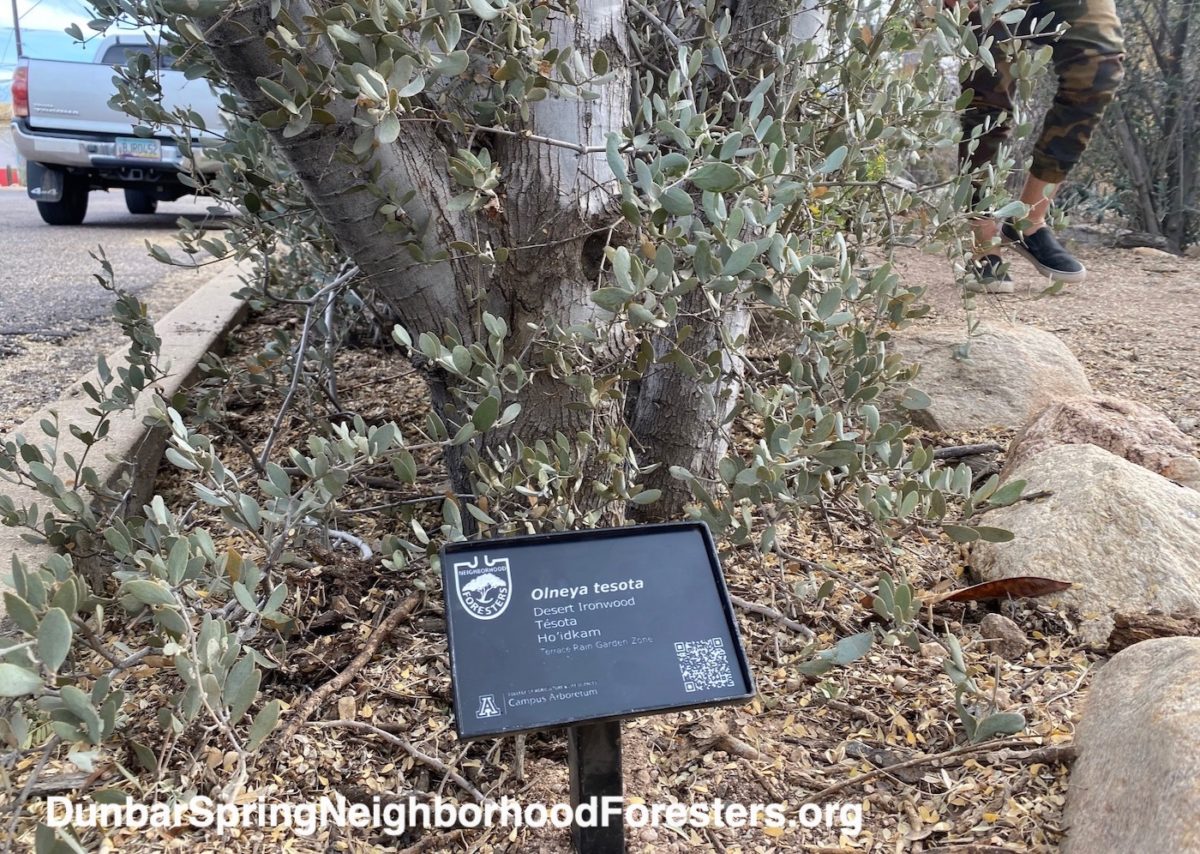Scroll down for 2024 updates.
Multi-lingual plant identification signs were just installed in the Dunbar/Spring Neighborhood Forest to help folks learn more about the rich Sonoran Desert life around them, and different ways they could deepen their understanding and collaboration with that life to help more take hold and succeed.

Each sign features a featured native plant’s name in English, Latin, Spanish, and O’odham; the ideal Rain Garden Planting Zone for that plant; and a QR code that when scanned with the camera of a smart phone, will pull up a webpage with more information on that plant such as its flowering season, its harvest season for ethnobotanical uses (parts of the plant used by people for food, medicine, crafts, etc.), harvest techniques, ideal planting season, landscape cultivation tips, plant’s characteristics, and the plant’s ecological benefits. See here for an example of the webpage the QR code links to on the Desert Ironwood tree sign.
These signs were created with funding from the University of Arizona Campus Arboretum, sign production by the University of Arizona sign shop, research and coordination by undergraduate student Jaime Rike and Dunbar Spring Neighborhood Forester Brad Lancaster, and further coordination by Campus Arboretum Director Tanya Quist.
The signs are in recognition, and support of, the high value of the Dunbar Spring Neighborhood Forest to the Tucson community, and how it functions as a satellite of the Campus Arboretum. The Dunbar Spring Neighborhood Forest extends throughout the public rights-of-ways of the Dunbar/Spring neighborhood, with the majority of the vegetation planted by neighborhood volunteers in annual plantings and stewarded by the adjoining property owners and Neighborhood Foresters volunteers. The bulk of this vegetation is freely irrigated with passively harvested rainwater and street runoff, which grows larger healthier plants to better shade/buffer us from our hot climate and the urban heat-island effect, while also reducing downstream flooding. Native plants are emphasized as they are the best adapted to our local climate, soils, and wildlife. Planting and stewarding species with high ethnobotanical value such as the production of food, medicinals, livestock fodder, and craft materials are prioritized.
Our hope is that we will continue to add more plant signs throughout the neighborhood over the years (we are currently working on an additional ten signs), as funding and resources become available. It is also our hope that this will lead to more neighborhood forests acting as satellites of the Campus Arboretum. This phase of the program has funded the creation of ten signs in total.
July 2022 an additional ten signs were installed by U of A campus arboretum interns.
July 2024 an additional 14 signs were installed by Brian Rasmussen, assistant director of the U of A Arboretum
See if you can find all thirty four of the plants identified with signs (can be a fun scavenger hunt with kids)—they’ve been installed within a two-block radius of University Blvd and 9th Avenue. To help in your search, the thirty four plants signed are:
Blue palo verde tree
Canyon hackberry tree
Catclaw acacia tree
Desert ironwood tree
Foothills palo verde tree
Screwbean mesquite tree
Velvet mesquite tree
White thorn acacia tree
Brittlebush
Canyon ragweed shrub
Chuparosa shrub
Condalia warnockii shrub
Creosote shrub
Desert cotton
Desert hackberry shrub
Desert lavender shrub
Fairy duster
Greythorn shrub
Jojoba shrub
Mormon tea shrub
Ocotillo
Oreganillo shrub
Triangle-leaf bursage
Wolfberry shrub
Barrel cactus
Christmas cholla cactus
Engelmann’s prickly pear cactus
Mammillaria cactus
Saguaro cactus
Staghorn cholla cactus
Agave murpheyi
Yucca elata (soaptree yucca)
The QR codes on the neighborhood’s plant ID signs are getting good traffic/use
According to a 7-26-24 email from Tanya Quist, director of the University of Arizona Arboretum, “The previous version of the [Dunbar/Spring Neighborhood Forest and plant ID signs] tour (posted in 2021) has had more than 2100 site visitors. The individual pages for the original 20 species average between 500 and 1500 visitors on each page. That’s a lot of learning about native trees happening!”
Here is a map of locations of plant ID signs installed thus far.
Would you like a plant ID sign for the part of the neighborhood forest you help steward?
Let Brad know by emailing him at neighborhoodforesters@gmail.com.
We received 14 duplicate signs from the Arboretum for the following plants. Let me know if you have a nice specimen that is growing along the path in the public right-of-way.
Brittlebush
Canyon ragweed
Christmas cactus
Desert cotton
Desert lavender
Fairy duster
Greythorn
Jojoba
Limberbush
Ocotillo
Saguaro
Soaptree yucca
Triangle-leaf bursage
